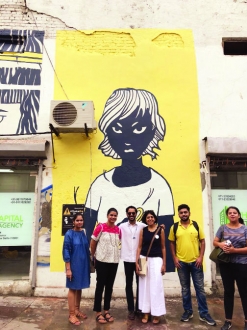A public art project by Leena Kejriwal and Change.org asks a startling question about human trafficking.
Giant black cutouts, all approximately 13 ft high, each representing an unknown girl from some remote part of India who has been trafficked for human consumption, are propped up against a bright afternoon sky at CP. They are faceless, nameless, expressionless, posing the silent question, “Where have they gone missing? Who has them now?”
“To me, it is not the black silhouette of a girl. It looks as if the sky has been cut out and a black hole looks through it rather menacingly, drawing in all the missing girls and sucking them into oblivion. There is a sense of loss for the ones who have lost their personality, their choices, their voices and their freedom. With approximately 5,000 drawings across the country and the globe, we want each cutout to ask one question, ‘Where does the demand for a million girls who disappear every year, come from?’ And I want to use these public installations to shake and stir us into corrective action,” says Leena Kejriwal, the mastermind behind The MISSING public art project for which she has collaborated with Change.org.
Talking about art as a means of activism, Kejriwal says, “People have used all kinds of media to engage with the public. I feel art has been underplayed in influencing people to take a stand or at least spark off a talking point.” And instead of focussing on the number of young girls that are lost to trafficking, this display asks the question, who have them, who is feeding the demand of the sex trade? Amogh Lux of change.org, therefore, created the hashtag #ChokeTheDemand. “Trafficking is demand-driven. Small acts like forwarding a rape joke can have a devastating impact in perpetuating the idea of the commodification of girls and women. Our Missing murals have a chat box that ask you to chat with it,” says Kejriwal. The deafening silence on the other side seems to have had an impact. “According to our internal surveys, around 75 percent of men said they would stop watching porn if that leads to trafficking,” she tells us.
Amogh, a communication designer, says, “I want to be an advocate of creativity; people don’t know how to measure artworks as a solution but the kind of impact and engagement you get is extremely powerful and that is something I am interested in investigating.” The wall art is mainly to engage urban India but he is holding a number of workshops in rural sectors, educating girls about safety, security and the need to earn a livelihood and equip oneself for it. Amogh explains how the chat boxes before the installations add a personal effect to the story of the victims. “For example, one of the murals in Kolkata explains that the cost of chicken is more than the cost of a girl. Now, if I tell you millions of girls disappear every year, you consider it a statistic. But the chicken-girl ratio hits you differently.”
Both Kejriwal and Amogh are trying hard to get a conversation going on breaking down patriarchal constructs, be it about gender roles, cultural values and societal customs. For example, they believe that talk about menstrual hygiene, though fragmented, is coalescing into a healthy dialogue on respecting otherness and the female voice. “I would not say that girls need to be their own bodyguards. We need to build a society where taboos are not hard to speak about.”
Nida Hasan, campaign director at change.org, says, “Kejriwal’s work speaks for itself. Trafficking has so far been talked about in terms of traffickers and number of girls being sold. We haven’t spoken about the customers, wondered who are these people who are forcing even 11-year-old girls into the sex trade? Who are fuelling the demand for pornography, even child pornography?”
After working with the Women and Child Welfare ministry, Kejriwal has toured three districts and holding workshops on how to be a “smart girl” and not just a “good girl.” Kejriwal’s reasoning is simple. “Why wait for a girl to get trafficked to save her? We are shaping her mind, trying to teach her about the many choices in life that will keep her away from coerced and feudal decisions. It is not about feminism, it is about creating awareness of equality. It is about changing a society that believes a girl has to behave in a certain way and live by a code. MISSING is only trying to tell you, ‘Hey, you are a human being with equal rights’ and slowly making the girls capable of thinking right. We are teaching them to be aware of their actions, even acceptance, and where they can lead. It is about pinching a social fabric that’s trying to sweep everything under it.”
This project began with the Kolkata chapter, Hunt for the Lost Durga, in 2017 and will be carried forward to Mumbai and Hyderabad, after completing the Delhi chapter in Connaught Place, Malviya Nagar and Vasant Kunj.
Writer: Shilpi Seth
Courtesy: The Pioneer








 OpinionExpress.In
OpinionExpress.In















Comments (0)